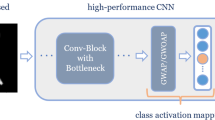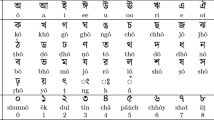Abstract
Deep convolutional neural networks-based methods have brought great breakthrough in image classification, which provides an end-to-end solution for handwritten Chinese character recognition (HCCR) problem through learning discriminative features automatically. Nevertheless, state-of-the-art CNNs appear to incur huge computational cost and require the storage of a large number of parameters especially in fully connected layers, which is difficult to deploy such networks into alternative hardware devices with limited computation capacity. To solve the storage problem, we propose a novel technique called weighted average pooling for reducing the parameters in fully connected layer without loss in accuracy. Besides, we implement a cascaded model in single CNN by adding mid output to complete recognition as early as possible, which reduces average inference time significantly. Experiments are performed on the ICDAR-2013 offline HCCR dataset. It is found that our proposed approach only needs 6.9 ms for classifying a character image on average and achieves the state-of-the-art accuracy of 97.1% while requires only 3.3 MB for storage.



Similar content being viewed by others
References
Kimura, F., Takashina, K., Tsuruoka, S., Miyake, Y.: Modified quadratic discriminant functions and the application to Chinese character recognition. IEEE Trans. Pattern Anal. Mach. Intell. 9(1), 149–153 (1987)
Iandola, F.N., Han, S., Moskewicz, M.W., Ashraf, K., Dally, W.J., Keutzer, K.: Squeezenet: Alexnet-level accuracy with 50x fewer parameters and \(<0.5\) mb model size. In: Computer Vision and Pattern Recognition (2016). arXiv:1602.07360
Liu, C., Yin, F., Wang, D., Wang, Q.: Online and offline handwritten Chinese character recognition: benchmarking on new databases. Pattern Recognit. 46(1), 155–162 (2013)
Yong, G., Qiang, H., Zhidan, F.: Chinese character recognition: history, status, and prospects. In: Proceedings of the 2002 IEEE International Conference on Acoustics, Speech, and Signal Processing, Orlando, FL, USA. IEEE (2002)
Liu, C.: Normalization-cooperated gradient feature extraction for handwritten character recognition. IEEE Trans. Pattern Anal. Mach. Intell. 29(8), 1465–1469 (2007)
Mangasarian, O.L., Musicant, D.R.: Data discrimination via nonlinear generalized support vector machines. In: Ferris, M.C., Mangasarian, O.L., Pang, J.S. (eds.) Complementarity: Applications, Algorithms and Extensions, pp. 233–251. Springer, Boston (2001)
Liu, C., Sako, H., Fujisawa, H.: Discriminative learning quadratic discriminant function for handwriting recognition. IEEE Trans. Neural Netw. 15(2), 430–444 (2004)
Krizhevsky, A., Sutskever, I., Hinton, G.E.: Imagenet classification with deep convolutional neural networks. Neural. Inf. Proc. Syst. 1097–1105 (2012)
Simonyan, K., Zisserman, A.: Very deep convolutional networks for large-scale image recognition. In: International Conference on Learning Representations (2015)
Szegedy, C., Liu, W., Jia, Y., Sermanet, P., Reed, S.E., Anguelov, D., Erhan, D., Vanhoucke, V., Rabinovich, A.: Going deeper with convolutions. In: Computer Vision and Pattern Recognition, pp. 1–9 (2015)
He, K., Zhang, X., Ren, S., Sun, J.: Deep residual learning for image recognition. In: Computer Vision and Pattern Recognition, pp. 770–778 (2016)
Ciregan, D., Meier, U., Schmidhuber, J.: Multi-column deep neural networks for image classification. In: Computer Vision and Pattern Recognition, pp. 3642–3649 (2012)
Ciresan, D.C., Meier, U.: Multi-column deep neural networks for offline handwritten Chinese character classification. In: International Symposium on Neural Networks, pp. 1–6 (2015)
Yin, F., Wang, Q., Zhang, X., Liu, C.: ICDAR 2013 Chinese handwriting recognition competition. In: Proceedings of International Conference on Document Analysis and Recognition (ICDAR), pp. 1095–1101 (2013)
Wu, C., Fan, W., He, Y., Sun, J., Naoi, S.: Handwritten character recognition by alternately trained relaxation convolutional neural network. Int. Conf. Front. Handwriting. Recogn. 291–296 (2014)
Zhong, Z., Jin, L., Xie, Z.: High performance offline handwritten Chinese character recognition using googlenet and directional feature maps. In: International Conference on Document Analysis and Recognition, pp. 846–850 (2015)
Zhang, X., Bengio, Y., Liu, C.: Online and offline handwritten Chinese character recognition: a comprehensive study and new benchmark. Pattern Recognit. 61, 348–360 (2017)
Chen, W., Wilson, J.T., Tyree, S., Weinberger, K.Q., Chen, Y.: Compressing neural networks with the hashing trick. In: International Conference on Machine Learning, pp. 2285–2294 (2015)
Xue, J., Li, J., Gong, Y.: Restructuring of deep neural network acoustic models with singular value decomposition. Conf. Int. Speech. Commun. Assoc. 2365–2369 (2013)
Jaderberg, M., Vedaldi, A., Zisserman, A.: Speeding up convolutional neural networks with low rank expansions. In: British Machine Vision Conference (2014)
Lebedev, V., Ganin, Y., Rakhuba, M., Oseledets, I.V., Lempitsky, V.S.: Speeding-up convolutional neural networks using fine-tuned cp-decomposition. In: International Conference on Learning Representations (2015)
Han, S., Mao, H., Dally, W.J.: Deep compression: compressing deep neural networks with pruning, trained quantization and huffman coding. In: International Conference on Learning Representations (2016)
Li, H., Kadav, A., Durdanovic, I., Samet, H., Graf, H.P.: Pruning filters for efficient convnets. In: Computer Vision and Pattern Recognition (2016). arXiv:1608.08710
He, Y., Zhang, X., Sun, J.: Channel pruning for accelerating very deep neural networks. In: The IEEE International Conference on Computer Vision (2017)
Lin, M., Chen, Q., Yan, S.: Network in network. In: International Conference on Learning Representations (2014)
Andrew, H.G., Menglong, Z., Bo, C., Dmitry, K., Weijun, W., Tobias, W., Marco, A., Adam, H.: Mobilenets: efficient convolutional neural networks for mobile vision applications. In: Computer Vision and Pattern Recognition (2017). arXiv:1704.04861
Xiangyu, Z., Xinyu, Z., Mengxiao, L., Jian, S.: Shufflenet: an extremely efficient convolutional neural network for mobile devices. In: Computer Vision and Pattern Recognition (2017). arXiv:1707.01083
Courbariaux, M., Hubara, I., Soudry, D., Elyaniv, R., Bengio, Y.: Binarized neural networks: training deep neural networks with weights and activations constrained to \(+1\) or \(-1\). In: Learning (2016). arXiv:1602.02830
Rastegari, M., Ordonez, V., Redmon, J., Farhadi, A.: Xnor-net: imagenet classification using binary convolutional neural networks. In: European Conference on Computer Vision, pp. 525–542 (2016)
Xiao, X., Jin, L., Yang, Y., Yang, W., Sun, J., Chang, T.: Building fast and compact convolutional neural networks for offline handwritten Chinese character recognition. Pattern Recognit. 72, 72–81 (2017)
Liu, C., Yin, F., Wang, D., Wang, Q.: CASIA online and offline Chinese handwriting databases. Int. Conf. Doc. Anal. Recogn. 37–41 (2011)
Abadi, M., Barham, P., Chen, J., Chen, Z., Davis, A., Dean, J., Devin, M., Ghemawat, S., Irving, G., Isard, M., et al.: Tensorflow: a system for large-scale machine learning. In: Operating Systems Design and Implementation, pp. 265–283 (2016)
Acknowledgements
This paper is supported by Beijing Technology Plan Project: Z171100002217094 and National Defense Science and Technology Project: 17-163-12-XJ-003-003-01.
Author information
Authors and Affiliations
Corresponding author
Rights and permissions
About this article
Cite this article
Li, Z., Teng, N., Jin, M. et al. Building efficient CNN architecture for offline handwritten Chinese character recognition. IJDAR 21, 233–240 (2018). https://doi.org/10.1007/s10032-018-0311-4
Received:
Revised:
Accepted:
Published:
Issue Date:
DOI: https://doi.org/10.1007/s10032-018-0311-4




